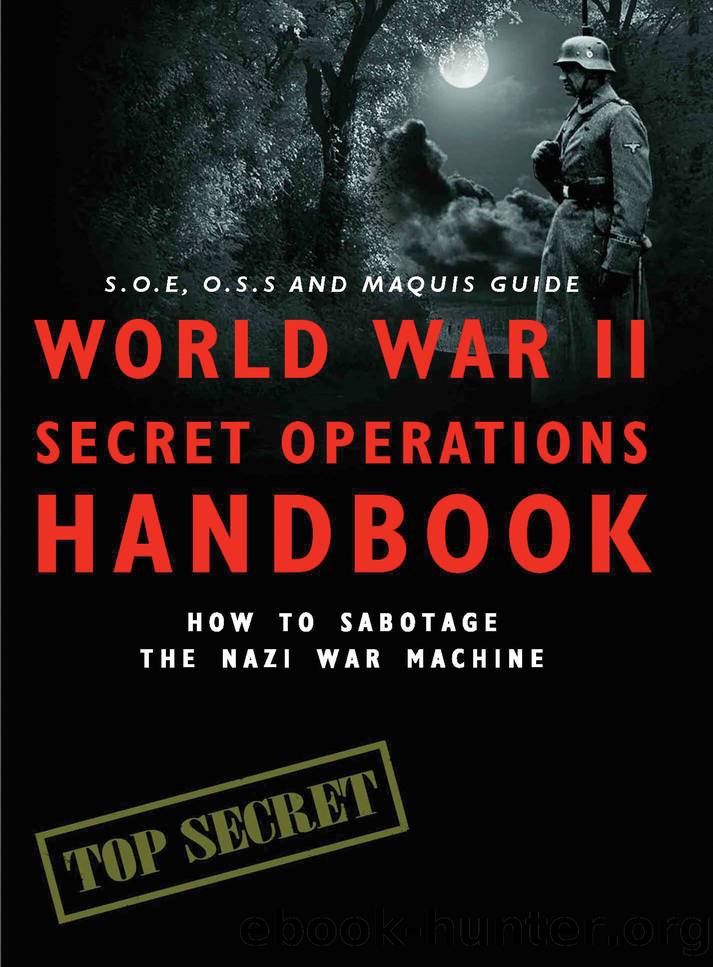World War II Secret Operations Handbook by Stephen Hart;Chris Mann;

Author:Stephen Hart;Chris Mann;
Language: eng
Format: epub
ISBN: 9781782741039
Publisher: Libreka GmbH
Published: 2020-02-21T00:00:00+00:00
Telephone Tap
To create a telephone tap, an operative covertly spliced an additional phone wire onto both the original phone lineâs out and return wires; the operative would then run these new wires to a nearby covert OP, where they were connected to headphones or a telephone receiver.
Telephone-tapping
Operatives could also acquire general intelligence through telephone-tapping â intercepting or eavesdropping on enemy conversations. To accomplish this, the operative had to locate a section of enemy telephone wire in a remote location away from any scrutiny. The operative then spliced two additional phone wires, one each onto the phone lineâs two cables that formed the circuit carrying the information from the telephone exchange to the telephone receiver at the end of the line.
The operative would then lay the two spliced lines across the ground, under cover, to a suitable facility such as a shed or a hide/OP where they were connected to headphones, or to another telephone receiver and/or a recording device. During 1944, for example, the Dutch Resistance used the expertise of two activists employed at the Dutch Central Telephone Exchange to establish taps into the national civilian telephone network.
The Resistance also managed to use these taps as the basis of a clandestine communications system that allowed disparate groups to communicate with one another. On certain occasions, such as when advancing American units first reached the southern tip of the Limburg pan-handle on 12 September 1944, they discovered that with Resistance assistance they could communicate via these taps into the public telephone network with Resistance operatives in the rest of the country that was still under German occupation. After several days, the Germans severed any extant lines that ran from German-controlled territory into areas of the country liberated by the Allies.
The Resistance also established several taps on German military lines and communicated the valuable intelligence gathered to the Allied authorities in the United Kingdom. These capabilities, exploited by the four âJedburghâ teams inserted into the region, facilitated communication between the various Allied units landed during Operation âMarket-Gardenâ, 17â25 September 1944.
Mission-specific Intelligence-gathering
In addition to gathering general intelligence, agents also sought to acquire mission-specific information, either for missions to be carried out by regular forces or by themselves. Operatives might execute missions to gain data on terrain and enemy defences to facilitate a subsequent Allied amphibious assault or an airborne landing. During 1943â44, for example, 12-man Combined Operations Assault Pilotage Parties (COPPs) were inserted at night onto the beaches of northern France to obtain data about these landing sites; they measured the profile of both the shallows and the beaches, and took samples of beach composition.
The teams were inserted by small motor craft or midget submarines to the vicinity of the beach; they then rowed in collapsible canoes or swam; in either case each man wore a special COPP wet-suit The operatives took with them a sounding line â a weighted rope knotted at fathom intervals (one armâs-stretch being used to approximate a fathom), a Chinagraph pencil (attached to the wetsuit by a short
Download
This site does not store any files on its server. We only index and link to content provided by other sites. Please contact the content providers to delete copyright contents if any and email us, we'll remove relevant links or contents immediately.
The Radium Girls by Kate Moore(11651)
100 Deadly Skills by Clint Emerson(4711)
The Templars by Dan Jones(4564)
Rise and Kill First by Ronen Bergman(4558)
The Doomsday Machine by Daniel Ellsberg(4262)
The Rape of Nanking by Iris Chang(4032)
Killing England by Bill O'Reilly(3903)
Hitler in Los Angeles by Steven J. Ross(3810)
Stalin by Stephen Kotkin(3733)
12 Strong by Doug Stanton(3426)
Hitler's Monsters by Eric Kurlander(3179)
Blood and Sand by Alex Von Tunzelmann(3072)
Darkest Hour by Anthony McCarten(3022)
The Code Book by Simon Singh(2884)
The Art of War Visualized by Jessica Hagy(2847)
Hitler's Flying Saucers: A Guide to German Flying Discs of the Second World War by Stevens Henry(2634)
Babylon's Ark by Lawrence Anthony(2447)
The Second World Wars by Victor Davis Hanson(2429)
Tobruk by Peter Fitzsimons(2384)
